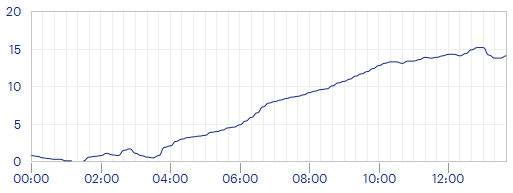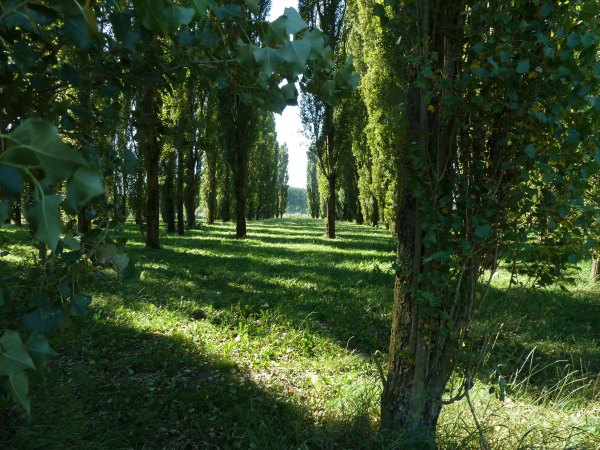Antique hardware
I brought some antique hardware to TkkrLab.
When I showed the motherboard of annabel, someone immediately noticed that the battery had gone
bad and had erode some part of the motherboard. After the battery was removed
and the motherboard had been cleaned it was powered up. It give some beep, but
nothing appeared on the screen. We tried it again with some card (IDE
controller, I believe) and again it gave some beep. But at some point we heard
some strange buzzing sound that seemed to originate from the power supply. We
switched it of. I saw some led light up shortly. When we switched it on, the
sound was gone, and the power supply worked normal. We checked to voltages and
they were fine. But how we tried to boot the mother board, it did not beep
again. A boot monitor is needed to debug it further.
Next, I showed my Acorn Atom. Although the
others were impressed by the DIY power supply, they were afraid the large
elektrolyt condensator could explode or at least fill the room with smoke. But
there was an alternative power supply available. It turned out that the Acorn
Atom only drew about 700mA, so every USB power supply would be enough. There
was also no television available, but with some soldering it was possible to
get a video signal and put that into a monitor with video input. And it work,
as can be seen on the picture. It left it at TkkrLab.
It is one of the oldest, if not the oldest piece of hardware at the
hacker space. Maybe we
can find some way to quickly load some games.
I also brought a Laser color computer 310,
but we did not look at because I had to go home early.
Institute for art history
Today, Peter Struycken and I visited the
Netherlands Institute for Art History, for
a second time. (July 23, 2015 was the first
time.) We continued working on the notes that Carel Blotkamp compiled for a
catalogue of works. After we finished it, we looked at some binders with
negatives and contact prints of art works. At his home, Peter showed me the new
works that he has made for the exhibition Dutch concert, P. Struycken en Carel Blotkamp that will open on
September 3. I was quite impressed by the new works.
20,000 days
Today, it is 20,000 days ago that I was born. I decided to celebrate this
special day by treat my colleagues on (small) cake and give a party for my
family and some friends. Not all my family could attend because of other
responsabilities. Five friends came. I received some cards and small presents.
If you want to know when you will be 20,000 days old, you can use:
Date Calculator: Add to or Subtract From a Date.
Last Tuesday, I received the DVB-T+FM+DAB stick
that I had ordered on July 22. Today, I
installed some software to receive
ADS-B signals, which are transmitted by aircraft. It did work with the
small antenna that was included with the DVB-T receiver stick. Of course, I
had to show it to everyone visiting.
Book
At 11:45, I bought the book Living inside the grid edited by Dan
Cameron written in English published by New Museum of Contemporary Art in 2003,
ISBN:9780915557868, from thrift store Het Goed
for € 2.95.
Last week, I got a good idea how to implement a data structure for
implementing parallel parsing, and in the past days I made a prototype implementation before intergrating it in IParse and, possibly, later intergrate it with MySample editor. This prototype implementation uses a very simple
mechanism to implement parsing rules. Terminals are simple character.
(Improved implementation)
Temperature at zero
Last night the temperature at ground level (10cm/4inch above, to be exact)
at the official weather station at Enschede Airport Twente dropped to zero. It is only the third time
that a temperature to or below zero is on record in August in the Netherlands
and the second time in Twente. It never dropped to (or below) zero between
July 20 and August 21.

Surreal number calculator
I worked on an online calculator for
Surreal numbers
using JavaScript. I did this a preparation
of a talk a plan to give with the title: "From Nim to
Go to Surreal Numbers".
Book
At 13:20, I bought the following three books, each for € 1.95, from
thrift store Het Goed:
- Eindexamencatalogus 1995 written by Kees Schippers and Sipke
Huismans, edited by Bas Könning, Boris Veldhuyzen van Zantern, Marijke
Harmens, Coen Scheen, and Sipke Huisman written in Dutch published by
AKI Akademie voor beeldende kunst in 1995,
ISBN:9789075522020.
- AKI eindexamen catalogus 2001: wat is de filosofie achter je werk?
written by Boris Veldhuijzen van Zanten, Nelleke Zandwijk, Sipke Huisman,
and Maarten Binnendijk written in Dutch and English published by AKI in
2001, ISBN:9789075522181.
- AKI 2003 edited by Peter Sonderen and Wouter Hooijmans
written in Dutch and English published by AKI Akademie voor Beeldende Kunst
in June 2003, ISBN:9789075522211.
I am planning to also include something about the game Domineering in my talk "From Nim to Go to Surreal Numbers".
While at TkkrLab, I decided to implement the
game on the IJduino. I got the idea to use a single potentiometer as the
interface. Players have to take turn placing a domino stone. By turning the
potentiometer a player can move through all possible locations. The selected
location can be indicated by a pair of blinking LED's. After the player has
stopped turning the potentiometer, the blinking frequency will get slower and
come to a halt. This gives the players some time to change their minds. Before
the players turns the potentiometer, nothing happens. I first had to find a
potentiometer. Another member was so friendly to donate a 10KΩ
potentiometer from an abandoned project. I had to do little rewiring to get
the potentiometer connected with all the other things already connected to it.
I did find a nice solution. First wrote a progam to check if I could read a
value from the potentiometer. Which was rather easy. Next I continued to work
on the program, which went without much trouble. I realized that the game
took rather long when using all eight by eight LED's of the display. I decided
to reduce it to five by five. But at the start of the game it is not clear
what are all available positions. I decided to invert the lights, making it the
goal of the game to make all LED's go of, which of course, with an odd number
of LED's is impossible. It turned out to be a nice way of signaling the winner,
as this is the player that has the last pair of LED's of her direction
blinking. I did notice that the value returned from the potentiometer at some
positions is not really stable if you do not turn, but I have not come up with
a way to fix this. The resulting program is:
domineering.ino. I also spend some time intergrating all my
previous programs in a single program, using the Bluetooth connection to
selecting the functioning, removing the need to reprogram the IJduino all the
time. I did not finish this.
Also had a look at the emfcamp badge:
a microcontroller with small display runing micro phython. I also talked
with some other member about the Acorn Atom
and the
SD/MMC card interface designed by Charlie Robson, which makes use of
pic16f874p controller. We agreed that I would order a pic16f874p. But at home,
I discovered that it seems that this controller is no longer on sale. I also
studied the various descriptions of the SD/MCC card interface, realizing that
they are quite old and I got the impression that there are are some holes in
the description. I wonder if it is possible to replace the PIC microcontroller by an ATmega168 microcontroller. I presume that the
communication between the Acorn Atom and the pic16f874p makes use of a
relatively low speed serial connection and that it would not be so difficult
to access an SD card. I downloaded two ROM images to be placed inside the Acorn
Atom for further analyses. This is going to be an interesting project.
Book
Yesterday, I bought three AKI finals catalogues. There were some more of them,
but they were already marked on a short list that I always me carry with me of
catalogues that I already own. Today, I noticed that it contained an error with
respect to 1992. I do own a small book from 1992, but it is not the finals
catalogue. I vaguely remembered having seen the yesterday, so, I went back this
afternoon to thrift store Het Goed, and found
it. At 17:26, I bought the AKI Akademie voor Beeldende Kunst
eindexamencatalogus 1992 edited by Bas Könning, Gerhard van Dragt,
Marijke Harmens, and Sipke Huismans written in Dutch published by AKI Akademie
voor Beeldende Kunst in 1992,
ISBN:9789073025042, for € 1.95.
Preparing for talk
This afternoon, I worked on preparing my talk "From Nim
to Go to Surreal Numbers". I prefer to give a talk in front of a black board
and just write down and draw things as I go along. I do not like preparing
slides, and especially not in PowerPoint. I thought about using strut, but after having wrestled with for an hour and discovering its
short comings, I decided to simply create a
webpage with HTML and JavaScript. During the
presentation I will simply scroll through the (zoomed in) page. It also
allowes me to start a short video clip and intergrate the Surreal number calculator, which I wrote last
Monday.
Disassembling ROM's
In the past days, I worked on disassembling two ROM's for the Acorn Atom that
can be found on AtoMMC2: An SD/MMC card interface. For this purpose I wrote a program
(based on source from the Acorn Atom emulator I
worked on long ago) that generates quasi C code for easy readability (at least
for me). I made use of a handy online 6502 disassembler,
Acorn Atom memory
map and disassembly of the Acorn OS ROM. I appended the output of the program
to this program listing (which I might update
in the future).
Saturday, August 20, 2016
Zomergo
In the afternoon, I arrived at Zomergo, a rather relaxed Go retreat. I was of the first to arrive. The first tournament round was
held in the afternoon. I won by resignation. On the right top the state of the
board at the end of the game. Dinner was quite late, as usual. Afterwards some
girls wanted to program the game snake on the IJduino. One of them had some experience with
programming and we succeeded in implementing it using the potentiometer, which
adds an additional constraint, because you cannot turn left (or right) too
often in a row, because you cannot turn the potentiometer in one direction
indefinitly.
(The snake.ino program.)
Sunday, August 21, 2016
Zomergo: Second day
In the morning, I played against a young woman, who just in the past year
learned playing Go, but appeared stronger than me. It
seems she is much better at reading than I, after I made a daring move (one
that should not work) she was able to capture a number of stones, after which
defeat was eminent. In the afternoon, I helped with preparing dinner for
about four hours gutting vegitables.
Monday, August 22, 2016
Zomergo: Third day
In the morning, I played against man and and won the game with a slim margin.
In the afternoon, I gave my talk about Nim, Go, and surreal numbers to about
eight people.
Tuesday, August 23, 2016
Zomergo: fourth day
In the morning, I played against woman and and won the game with nine and half
points. I also worked on perfecting a short
script for MySample to extract the state
of a Go board from a 190 by 190 pixel image. The output of the script is used
to display the Go board position at the end of my games.
Wednesday, August 24, 2016
Zomergo: Fifth day
In the morning, I played against young man and and lost the game with nine and
half points. From the start of the game, I felt uncomfortable about it. Half
way, I thought about resigning, but still continues. My opponent suggested that
I could still invade some corner. Because I had not seen this myself, I did
not feel comfortable trying it. He felt that I regain some of my loss towards
the end of the game.
In the afternoon, I helped with preparing the dinner. In the evening, there
was a rather clear sky and with relatively less light polution, one could see
many stars. We walked to a nearby field where it was darker. We could see
(part of) the milky way.
Zomergo: Last day
In the morning, I played against a young girl. I had to give her nine stones
ahead. At first it seemed that she was going to make a lot of territorium in
the center, but soon, I was sure of victory, but I did not want her to lose
big, so I made many 'stupid' moves, and allowed her to close some place where
I could invade. Nevertheless, she still lost with about seventy points.
Afterwards, we played another 'teaching' game on a thirteen by thirteen with
five stones ahead, and with my suggestions, she easily won that game.
In the afternoon, I visited The Green Cathedral, a landscape artwork by Marinus Boezem. I walked
around and through it, and took some pictures. The GPS-track of how
I traveled today in KML file for Google Earth or in Google Maps
Parallel parser improved
Since I wrote about a parallel parser on 9th, I have been
working on fixing problems with memory deallocation. I soon realized that not
all parse state representing objects were deleted, as soon as they no longer
could be reached, and that actually most of them were not deleted at all.
Although this does not show in the output of the first published
implementation, I do find it an essential requirement, especially when the
purpose of the algorithm is to be used to parse lines in an editor over and
over again, causing the memory footprint to grow with every keystroke. In the
process the code has been changed considerable. The current version also contains a lot of tracing code, because it took me
quite a lot of time to figure out what was going wrong and how to fix it. The
idea is to integrate this prototype with the existing IParse implementation.
TkkrLab fun
Fun things this evening at TkkrLab
Tried to install Android development
environment.
Impatiens glandulifera
I already had suspected that one of the seeds of an impatiens glandulifera that I had put in the garden two years ago, some
time after I found the plant on August 18, had
started to grow, but now I know for sure, when I saw that it had produced a
flower. The plant did not look very healhty and immediately I gave it some
water. Here on the top right a picture. This is know to be a one year plant and I was a little
surprised to see it, because it is two years ago that I planted the seeds and
did not know that it could survive so long. I do not know if it will produce
seeds, because I guess that the flower needs to be pollinated and I am not
aware of other plants in the neighbourhood.
This months interesting links
Home
| July 2016
| September 2016






 Tuesday, August 2, 2016
Tuesday, August 2, 2016
 The Green Cathedral
The Green Cathedral Wednesday, August 31, 2016
Wednesday, August 31, 2016